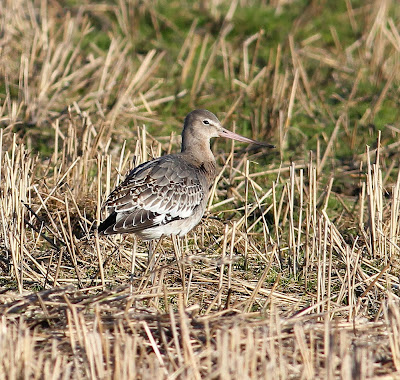The morning began bright and breezy with gusts teetering on the edge of being “windy”, a subtle difference that birders will recognise whereby choosing a place to go birding requires a little forethought. Pilling was the decision and where after a three hour slog around the patch the old notebook had a good few entries.
The flooded maize received a watery top-up last night although the soggy fields didn’t need it by virtue of the regular stuff there: 160 Redshank, 45 Lapwing, 28 Dunlin, 15 Skylark and 2 Little Egret. More than a few of the Lapwings and the Skylarks were in display mode.
Two Buzzards came from over the Fluke Hall woods, circled around for a while and then headed off in the direction of Pilling village and the mosses beyond. The wood was a bit windswept for birdsong but I did see a pair of Stock Dove in the trees, 25+ Woodpigeon feeding on the ground and a handful of Goldfinch.
Buzzard
Woodpigeon
Beyond the wood I checked out the fields to find 18 Pied Wagtail, 6 Oystercatcher, 15 Curlew, 4 Greenfinch, 4 Meadow Pipits, 1 Reed Bunting and a couple of dozen Pink-footed Geese.
When the Meadow Pipits flew across to the beach I noticed their arrival and calling had pushed other birds into the air, and on checking I found the pipits chasing off 3 Snow Buntings. In the ensuing melee a flock of 40+ Twite lifted off the marsh then circled around to find a new spot on which to feed. The buntings seemed to head west along the sea wall and although I spent some time trying to relocate then I couldn’t, so I imagine they carried on towards Preesall, Knott End or Fleetwood. In the strong breeze blowing along the shore everything seemed very flighty and reluctant to stay in one spot for long.
Snow Bunting
Heading east I found more wagtails behind the sea wall, 5 Whooper Swans, 7 Little Egret, 5 Teal, 3 Red-legged Partridge and a couple of hundred scattered Pink-footed Geese. There don’t appear to be many pinkies around at the moment so maybe many have flown north towards Iceland already.
Whooper Swans
It was last December 2013 near Pilling Water that I spotted a Pink-footed Goose wearing a neck-collar, the collar inscribed with the letters “TAB”. I reported the sighting online and yesterday received back the following information from The Wildfowl and Wetland Trust about when and where the pinkie was ringed and all the subsequent sightings. My own sighting at the bottom of the list is the most recent.
There’s a clear pattern to the bird’s seasonal movements. After spending the summer months in Iceland the goose migrates south, probably stopping off in Scotland. It then spends part of the early winter in Lancashire or Norfolk, but seems to spends each New Year in Norfolk. By February, March and into April it is back in Scotland feeding up for its Spring flight to Iceland. There are an awful lot of flights to Iceland and back not included in the list below. Aren’t birds amazing?
20/10/2006 Loch of Lintrathen ANGUS, Scotland - adult female Pink-footed Goose first caught then marked with “TAB”.
15/02/2007 Wester Dalziel, Dalcross INVERNESS, Scotland
01/03/2007 Balnaglack, Dallcross INVERNESS, Scotland
03/04/2007 Morayhill, Dalcross INVERNESS, Scotland
18/11/2007 Breydon Water area, Great Yarmouth NORFOLK, England
24/11/2007 Pollard Street, Bacton NORFOLK, England
01/12/2007 N of Sharrington NORFOLK, England
19/12/2007 Runham NORFOLK , England
05/01/2008 Repps Mill NORFOLK, England
16/01/2008 Repps Mill NORFOLK, England
23/01/2008 Thrigby NORFOLK, England
28/02/2008 Gellybanks area, Loch Leven PERTH & KINROSS, Scotland
09/04/2008 Lower Cullernie, Balloch INVERNESS, Scotland
02/11/2008 Fluke Hall Lane, Pilling LANCASHIRE, England
08/11/2008 Bone Hill Fram, Pilling LANCASHIRE, England
08/01/2009 Preesall Park, Preesall LANCASHIRE, England
08/01/2009 Cockers Dyke, Pilling LANCASHIRE, England
03/02/2009 Head Dyke Lane, Pilling LANCASHIRE, England
02/03/2009 Wester Dalziel, Dalcross INVERNESS, Scotland
07/03/2009 Cullernie INVERNESS, Scotland
25/03/2009 Easter Dalziel, Dallcross INVERNESS, Scotland
30/03/2009 Easter Dalziel, Dallcross INVERNESS, Scotland
03/04/2009 Wester Dalziel, Dalcross INVERNESS, Scotland
19/03/2010 Wester Dalziel, Dalcross INVERNESS, Scotland
01/04/2010 Wester Dalziel, Dalcross INVERNESS, Scotland
05/04/2010 Wester Dalziel, Dalcross INVERNESS, Scotland
05/11/2010 Hall Farm, Rollesby NORFOLK, England
01/12/2013 Dam Side, Pilling LANCASHIRE, England
The bird below isn’t “TAB”, on 1st December 2013 she was far away, the inscription read via a telescope at 200 yards or more. I’m sure however that the bird below is an equally amazing pinkie.
Pink-footed Goose
More soon from Another Bird Blog. And remember, you read it here first.
Linking today to
Eileen's Saturday Blog.



















































































